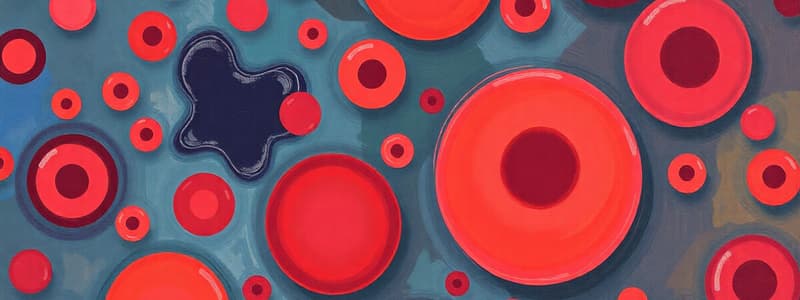Podcast
Questions and Answers
What is the average diameter of a healthy erythrocyte?
What is the average diameter of a healthy erythrocyte?
- 12 μm
- 9 μm
- 7.5 μm (correct)
- 6 μm
Which type of leukocyte accounts for 60-70% of circulating leukocytes?
Which type of leukocyte accounts for 60-70% of circulating leukocytes?
- Basophils
- Eosinophils
- Lymphocytes
- Neutrophils (correct)
What is a distinguishing feature of eosinophils?
What is a distinguishing feature of eosinophils?
- Bilobed nucleus (correct)
- Segmented nucleus
- Spherical nucleus
- Multilobed nucleus
How long is the life span of a typical erythrocyte?
How long is the life span of a typical erythrocyte?
Which leukocyte is primarily responsible for cell-mediated immunity?
Which leukocyte is primarily responsible for cell-mediated immunity?
What is the percentage of basophils in circulating leukocytes?
What is the percentage of basophils in circulating leukocytes?
What is a common abnormal shape of an erythrocyte?
What is a common abnormal shape of an erythrocyte?
What is the function of thrombocytes?
What is the function of thrombocytes?
What type of granules do neutrophils contain?
What type of granules do neutrophils contain?
Which stem cells differentiate into myeloid cells?
Which stem cells differentiate into myeloid cells?
Flashcards
What are Erythrocytes?
What are Erythrocytes?
The most abundant cells in the blood, responsible for oxygen transport. They are flexible, biconcave discs with a diameter of 6-9 μm and a thickness of 2.5 μm at the rim and 0.75 μm in the center.
What are Thrombocytes?
What are Thrombocytes?
A specialized type of cell that helps in blood clotting. They are not true cells, but rather fragments of cytoplasm. They are smaller than erythrocytes, with a diameter of 2-4 μm.
How is a blood smear prepared?
How is a blood smear prepared?
A stained blood smear is used to visualize blood cells under a microscope. It involves spreading a thin layer of blood on a slide, letting it air dry, fixing it with methanol, and staining it with dyes.
What are Leukocytes?
What are Leukocytes?
Signup and view all the flashcards
What are Neutrophils?
What are Neutrophils?
Signup and view all the flashcards
What are Eosinophils?
What are Eosinophils?
Signup and view all the flashcards
What are Basophils?
What are Basophils?
Signup and view all the flashcards
What are Lymphocytes?
What are Lymphocytes?
Signup and view all the flashcards
What are Monocytes?
What are Monocytes?
Signup and view all the flashcards
How are blood cells produced?
How are blood cells produced?
Signup and view all the flashcards
Study Notes
Blood Cell Development
- Blood is composed of water, plasma proteins, electrolytes, nutrients, respiratory gases, and waste products.
- Erythrocytes (red blood cells) account for 4.2-6.2 million per cubic mm.
- Leukocytes (white blood cells) include neutrophils (60-70%), lymphocytes, monocytes, eosinophils, and basophils. Lymphocytes are 20-25% and include T-cells, B-cells, and natural killer cells.
- Platelets (thrombocytes) have a normal count of 150,000 to 400,000 per μL of blood.
- Erythrocytes are flexible, biconcave discs, non-nucleated, and appear ac-dophic with a pale center.
- Erythrocyte size ranges from 6-9µm, with a thickness of 2.5 µm at the rim and 0.75 µm in the center.
- Erythrocytes have a lifespan of 120 days.
- Abnormal shapes of erythrocytes include sickle cells and spherocytosis. Abnormal sizes include microcytic (diameters less than 6µm) and macrocytic (diameters greater than 9µm).
- White blood cell types encompass granulocytes (neutrophils, eosinophils, basophils) and agranulocytes (monocytes, lymphocytes).
- Neutrophils have segmented, multilobed nuclei (2-5 lobes), and cytoplasmic granules.
- Eosinophils have a bilobed nucleus and large, acidophilic cytoplasmic granules.
- Basophils have a bilobed nucleus and have specific granules that obscure the shape of the nucleus.
- Monocytes are the largest cells in blood smears and have large, indented, C-shaped or kidney-shaped nuclei.
- Lymphocytes are small and slightly clefted or slightly indented. Small lymphocytes and large lymphocytes are distinguished morphologically.
- Platelets are small, non-nucleated, membrane-bound cell fragments.
- Blood smears show platelets in clumps, with a lightly stained peripheral zone.
- Hemopoiesis is the formation and development of blood cells from pluripotent stem cells in bone marrow.
- Myeloid stem cells differentiate into granulocytes (neutrophils, eosinophils, and basophils), monocytes, and erythrocytes, while lymphoid stem cells form lymphocytes.
- CFU (colony-forming unit) classifications in heamatopoiesis lead to different lineages of blood cells.
- Various growth factors (e.g., EPO, G-CSF, M-CSF) regulate specific blood cell development.
Studying That Suits You
Use AI to generate personalized quizzes and flashcards to suit your learning preferences.




